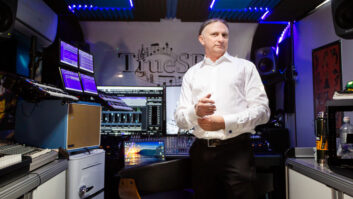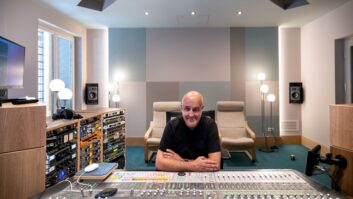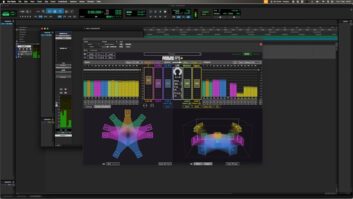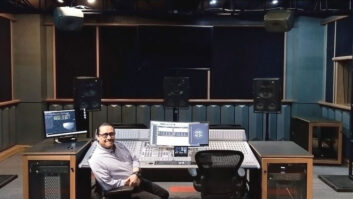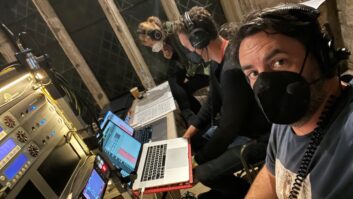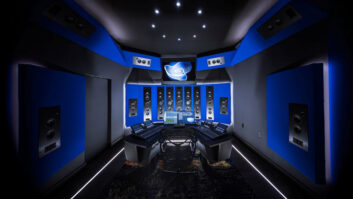Taking the stereo image beyond its obvious boundaries has been in the engineer’s toolbox since the discovery of mechanically induced flanging in the ’60s and the introduction of hardware effects like the phase shifter and Eventide’s Harmonizer in the ’70s. Later, in the ’90s, QSound and Bedini entered the market with their 3-D sound-processing algorithms and the Bedini Audio Spectral Enhancer (BASE), which promised an enhanced listener experience for music and gaming.
In the current age where computers are fast, and portable devices for entertainment and gaming and communication are plentiful and cheap, the questions have changed. Can I create credible 5.1 effects from two speakers for critical listening in the home, at the studio or on headphones? What’s more, can I deliver real-time, high-quality surround to portable stereo devices like a laptop, pad, headphones, gaming console, smartphone and auto? As you’ll read below, the answers are all yes: The surround-from-stereo game is afoot.
DIFFERENT APPROACHES
Because of the popularity of portable formats and the recent upsurge in 3-D TV and movies, the stereo-to-multichannel toolset has grown exponentially. Being that manufacturers are designing these tools for different users (pros and consumers), listening venues and output platforms, the approaches are numerous. For instance, some methods are playback device–agnostic: Encoding is done entirely at the front end for listening on any device, no matter if they’re headphones or speakers large or small. Other methods call for DSP at the back end, meaning you need a specific chip-level encoder/decoder in your playback device, whether it’s portable or not. These are often input-agnostic, meaning any source can be upmixed on the spot into 5.1, whether stereo from iTunes, YouTube, MP3 or any other 2-channel source. Other systems call for encoding, then playback decoding to a specific device such as a headworn system. Some of these are not transferable outside the specific gear and are even sometimes specific to a single user. As you can see, the prospect of delivering surround from two speakers is getting pretty thick.
MAJOR PLAYERS
There’s no argument that Dolby and DTS have brought 5.1 audio for post, broadcast, music and gaming to literally millions of users across a broad range of devices. On the encoding side, Dolby’s professional product set includes DP563 Dolby Surround and Pro Logic II Encoder, which encodes discrete 4- or 5-channel surround mixes into Left total/Right total (Lt/Rt) stereo to be delivered over two channels on stationary and portable devices. In addition, Dolby Pro Logic IIx allows upmixing from stereo or surround 5.1/7.1 to 7.1 Height or 9.1 with the addition of front-height channels.
Dolby also has a range of products found mostly on consumer notebooks priced between $400 and $800. The latest chip-level software for this market is Dolby PC Entertainment V. 4, just released at CES in Las Vegas, which promises to deliver a cinematic surround experience on portable devices. Kevin Brennan, senior product marketing manager, PC Segment, explains how the Dolby codec works: “If the content is 5.1, it leaves the content alone and does all the other processing we do on that version. If it’s stereo content, it upmixes it to 5.1 and does the additional processing to the upmixed version.” The additional processing to which Brennan refers to improves the intelligibility of dialog, levels the volume and adds some equalization. Some of these parameters are user-adjustable. “We’ve spent a lot of time and effort providing a UI set that allows the user to quickly enable, disable and configure the software,” explains Brennan. “It is important to have some level of configurability because not all content is created equally.”
What about latency for picture or games? Brennan answers, “The technology uses the Intel High-Definition Audio System, which is a standard that Microsoft, Intel and Dolby created. Any audio stream opened within the PC gets processed through the same audio path. In terms of latency between video and audio, it doesn’t arise; it’s compensated for within the PC.”
DTS offers a range of products for surround upmixing, starting with the Neural Upmix plug-in (reviewed in Mix October 2010). “It was originally used in our real-time broadcast products, and we developed it into a plug-in after we discovered that it sounded fantastic,” says DTS pro audio manager Tom McAndrew. Neural Upmix is a Pro Tools and VST plug-in that gives you 5.1 from two channels or 7.1 from 5.1. The discrete multichannel output is then encoded for Blu-ray or broadcast. The process promises zero artifacts if it’s downmixed. “That’s been sort of a dirty secret of some competing upmixing products,” McAndrew explains. “When you play the mix back in a consumer environment where it has to be downmixed back to two channels, it can create some phase and volume funk. This product does not do that.”
For consumer devices, DTS offers DTS Neo and Neural modes for A/V receivers and DTS Premium Suites for PCs. The suite offers a host of features including surround virtualization, bass boost, and volume leveling and normalizing, all within the suite’s sub-processors. For instance, DTS Surround Sensation UltraPC boasts an excellent surround listening experience from two speakers or headphones, whether the original content is stereo or multichannel. DTS Connect combines DTS Neo: PC and DTS Interactive for surround upmixing and digital connection of the PC to the home theater system via a high-quality digital audio connection.
MORE SOLUTIONS
GenAudio offers a range of current and planned products for consumer and pro. Its AstoundSound! process boasts an unparalleled 3-D listening experience from two speakers or headphones. The downloadable Expander 3 plug-in is targeted at consumers. It runs as a background process on a PC or Mac, encoded right on the computer, creating an immersive experience for movies, gaming or music no matter the content. The plug-in offers a simple user interface that allows you to adjust basic functions according to taste.
On the pro-encoder side, GenAudio has plans for DAW plug-ins that will be “open to the public” for purchase, but the main way of getting GenAudio’s process into a production for release for CD, Blu-ray or DVD media is to have the audio encoded at the company’s studios in L.A. or another of its sanctioned locations. This process is being used for the Monster Audio CD release of the Daft Punk soundtrack from Tron, which comes with a top-grade headworn listening device.
SRS has been a leader in the field of virtual surround games for a while, offering products for home entertainment, headphones, PC, smartphones, portable devices and auto. SRS’ HD Audio Lab (HAL) plug-in promises maximum compatibility over a wide array of media players and soundcards. It lets the user select audio content, choose the speaker type (internal PC, external or headphones) and then further adjust the audio through the use of advanced controls. The company’s latest offering is TruMediaHD, which promises a cinematic listening experience over a mobile device’s built-in speaker(s) or headphones. Features include psychoacoustic 5.1 surround sound over headphones, improved tonal clarity of compressed audio, volume maximizing and leveling, and a user-adjustable graphic EQ.
QSound, one of the originators of products for surround from two channels, offers products for mobile devices, headphones, Bluetooth devices, TVs, PCs and more. Its products are available exclusively through a licensing agreement with the company, and they vary in features, depending on the delivery platform. The surround family of products comprises QSurround HD, a multichannel virtualizer designed for playback over stereo speakers; QSurround 5.1, a multichannel virtualizer that works with any multispeaker configuration; and QSurround Headphones, a multichannel virtualizer offering HRTF algorithms for headphones.
TC Electronic’s UpCon HD, for its DB4 and DB8 processors, is stereo-to-5.1 upmixing software with functions and settings suitable for broadcast programming. Promising 1 ms of latency, it’s compliant with downmix to stereo or mono. On the film side, the UnWrap HD for TC’s S6000 is an up-conversion stereo-to-5.1 processor for dialog, music and sound effects.
ON YOUR HEAD
Designed for the critical listener wanting to replicate physical speakers in a particular space while wearing headphones, Smyth Research’s Realiser A8 freestanding processor combines multiple channels of surround sound, adding the directional signatures that would be imposed on each channel by the positions of the loudspeakers. It comprises the desktop processor with controls for setup, operation, audio I/O and more. Also included is the RC-1 remote control, HTM-1 miniature mics for in-ear measurements, TU-1 wireless rechargeable head tracker for attachment to any headphones, TR-1 head-tracking reference for placement in front of the listener and Stax SR-202 headphones.
To set up the system, the listener wears the HTM-1 in-ear mics while the system produces tones in a particular audio space through its regular speaker system. A profile is then stored for that room and that listener, and the profile can be reproduced over headphones. Users can model and store different rooms for specific listeners. The TU-1 and TR-1 follow the listener’s head movement and adjust the audio so that the listener’s experience is similar to moving his/her head in the room. Profiles are user-specific, making it the priciest and least-portable headworn system available.
Targeted for armchair enjoyment of music, film, TV and computer-based entertainment, beyerdynamic’s Headzone surround headphone system comprises the HBC 1 base station and the DT 880 headphone. It is compatible with Dolby Digital, DTS or Dolby Pro Logic streams, and has drivers for use with Mac or PC. It offers user-adjustable room-modeling controls of ambience and room size from a single dial, and volume control from the headphone cable. DT 880 headphones have a hybrid semi-open design that combines the strengths of open, transparent ’phones with those of more powerful, closed models. It also features head tracking, in which integrated, ultrasonic sensors keep the acoustic image centered no matter how the listener’s head is moved.
The options are many for the producer and the consumer. HTC has begun advertising phones on TV with a Dolby Surround hook, and no doubt there’s great interest from mobile gamers. And these developments in surround playback just might stimulate the music surround market. We’ll be listening.
Kevin Becka is
Mix
’s technical editor.

